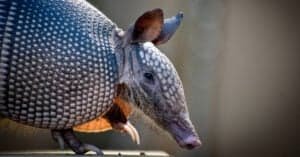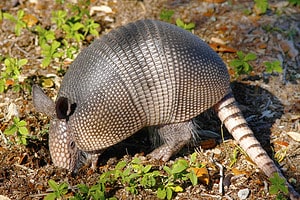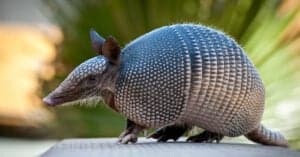Armadillos live in many different areas within the United States. It is very common to see their tracks in the dirt and mud. Although there are multiple species of armadillo, the tracks look somewhat similar to one another.
Depending on the substrates on which the armadillos are walking, you may be able to point out armadillo tracks. Keep reading to learn about armadillos and defining features of armadillo tracks!

Although there are multiple species of armadillo, the tracks look somewhat similar to one another.
©Klaus Balzano/Shutterstock.com
What Is an Armadillo?
Armadillos have a unique appearance, with a leathery shell of armor on the outside and long, sharp claws that enable them to dig and burrow. They can vary quite a bit in size, depending on the species. The average armadillo is about 30 inches long, including its tail.
The smallest species is the pink fairy armadillo – it weighs about 3 ounces and is about 5.1 to 5.9 inches long. The giant armadillo is the largest, and it can be up to 59 inches long and 119 pounds.
Armadillos primarily eat invertebrates, such as grubs and insects. They are very good at digging, using their sharp claws to find food underground and dig burrows. They do not have good eyesight, using their very strong sense of smell to find prey.
Although armadillos have short legs, they are able to move fairly quickly. The armor shell on the surface is very important as a defense mechanism. Many of them escape predators by running into thorny patches, which do not hurt them because of the shell.
There are a few natural predators of armadillos, including alligators, bobcats, and coyotes. However, human-driven vehicles are the biggest threat to their survival.
In the United States, armadillos are mostly found in the southwestern states, although some have migrated to northern states. Of all the armadillo species, only the nine-banded armadillo lives in the US. Armadillos are much more commonplace in Central and South America.
Armadillo Tracks
Armadillos have unique tracks. These prints can be confused with those of raccoons or opossums, but you can learn to differentiate them by their specific patterns. There are different types of armadillos and subtle differences in the tracks between them.
Six-Banded Armadillo

This is a solitary animal with a nocturnal lifestyle. The armadillo is in its burrow all day.
©mariamalaya/Shutterstock.com
The six-banded armadillo is usually about 19.7 inches long and can weigh up to 13.2 pounds. It prefers places that are open and dry, with varied vegetation. This armadillo eats insects, plants, small vertebrates, and sometimes carrion. This is a solitary animal with a nocturnal lifestyle. The armadillo is in its burrow all day.
There are three toes on the hind footprint, with the two internal toes going in the same direction as the tracks. The front footprints feature three toes with claws. The footprints are 0.8 to 1.0 inches long and 1.6 inches wide.
Nine-Banded Armadillo

They typically eat fungi, fruits,
insects
, eggs, and small vertebrates.
©iStock.com/6381380
The nine-banded armadillo, on average, is about 19.7 inches long and 8.8 pounds in weight. They live in open land areas, as well as forest areas. They typically eat fungi, fruits, insects, eggs, and small vertebrates.
You can usually see them in the morning and later in the afternoon. The hind footprints show three open, long toes. The third toe is typically the largest. The front footprint shows too close digits that are parallel to one another. The tracks of these armadillos can be up to 1.4 inches long and 1.2 inches wide.
Giant Armadillo
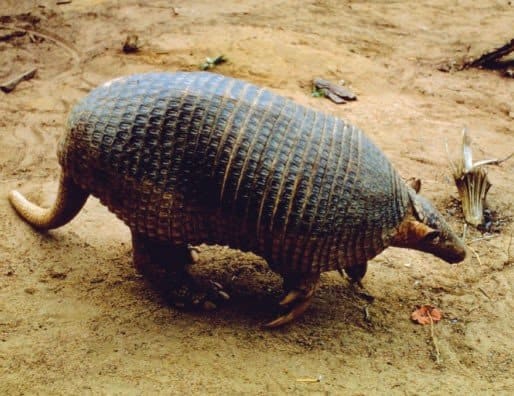
These armadillos have front footprints that show two claws, even though they actually have five claws on the front paw.
©amareta kelly / CC BY 2.0, Flickr – License
The giant armadillo is the biggest and also the rarest armadillo that exists. They weigh over 110 pounds and are over 39 inches long. They generally eat insect larvae, worms, and sometimes even snakes.
These armadillos have front footprints that show two claws, even though they actually have five claws on the front paw. There are three short, stocky toes on the hind print. The prints can be between 2.4 and 3.2 inches long and 3.0 to 3.8 inches wide.
Defining Features of Armadillo Tracks
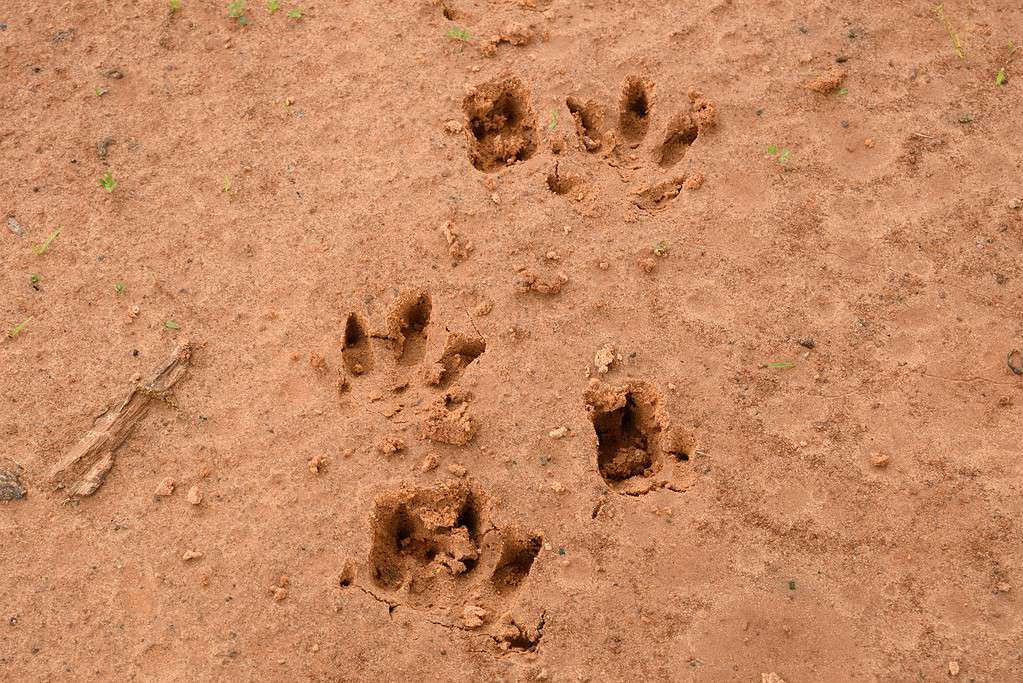
A marker of armadillo tracks is that they have four long toe prints. Each of these toes has a sharp claw at the tip.
©Sari Oneal/Shutterstock.com
Toes, Track Shape, and Pattern
A marker of armadillo tracks is that they have four long toe prints. Each of these toes has a sharp claw at the tip. Their toes are spread out in their tracks. In a footprint, what resembles the letter “V” can be seen between the middle toes. Many sets of armadillo tracks will come with a line between the footprints – this is the imprint from their tail dragging on the ground.
Armadillo Tracks in the Mud
Armadillos often live in areas that receive a significant amount of rain, so it is common to see armadillo tracks in the mud. You should be able to see their four toe prints with the claws at the tip and the “V” shape between the middle toes.
The line where their tail drags along the ground should also be visible. In very soft mud, you may not be able to see very well-defined armadillo tracks.
Armadillo Tracks in the Snow
You are fairly unlikely to see armadillo tracks in the snow because they generally aren’t out and about in the winter. They are actually tropical animals, although many have migrated into the much colder northern parts of the United States, including Illinois and Nebraska.
Armadillos aren’t capable of hibernating, and they don’t have the bodily features that many other mammals have to keep them warm in the winter, such as copious amounts of body fat or thick coats.
Armadillos dig burrows up to 15 feet in length and spend the majority of their time in them during the winter. These burrows give them the natural insulation that their bodies lack during times of cold weather. Armadillos survive winters when there are natural supplies of worms and insects where they are staying.
If armadillos are walking on land in the winter, it is likely a warm day with no snow on the ground. This is why it is very rare that you will see armadillo tracks in the snow. However, if you do, they are likely to appear in the same pattern as they do in the mud or dirt.
Armadillos as Pests
Armadillo tracks are important because you can tell by their presence that an armadillo has been in the area recently. Armadillos travel very slowly, at not even one mile per hour. Additionally, once they have settled into an area, they typically will not go further than one-tenth of a square mile away.
If armadillos are living around your property, it is likely that they will cause significant damage. They burrow quite a bit, damaging home foundations, fences, and driveways. They also cause damage to flower beds and vegetable gardens when they are feeding on insects and foliage.
There are a few things that you can do to discourage armadillos from burrowing around your property. If you remove brushy areas, this might deter them. Barriers around gardens that slant outwards may also stop them from destroying gardens.
The photo featured at the top of this post is © Heiko Kiera/Shutterstock.com
Thank you for reading! Have some feedback for us? Contact the AZ Animals editorial team.



